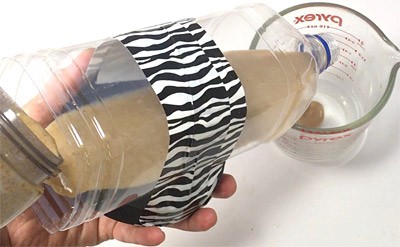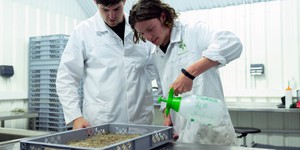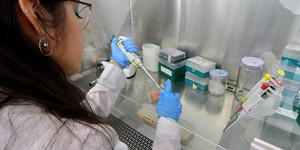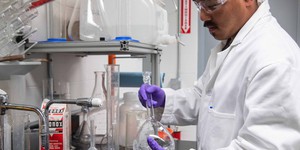Abstract
How much iron is in your cereal? In this experiment, you will devise a way of testing foods for supplemental iron additives. Then you will use your design to test different breakfast cereals to see how much iron they contain. Which brand of cereal will have the most iron in it?Summary
This project was adapted from a student project submitted to the Marin County Science Fair in California.
Sara Agee, Ph.D., Science Buddies
Teisha Rowland, PhD, Science Buddies
- Cheerios® is a registered trademark of General Mills, Inc. All rights reserved.
- Fruit Loops® is a registered trademark of Kellogg Company. All rights reserved.
- Kix® is a registered trademark of General Mills, Inc. All rights reserved.
- Special K® is a registered trademark of Kellogg Company. All rights reserved.
- Total® is a registered trademark of General Mills, Inc. All rights reserved.
Objective
In this experiment you will devise a method of extracting supplemental iron from food to compare the iron content of several brands of breakfast cereal.
Introduction
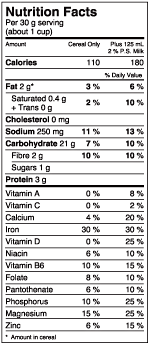 Image Credit
Image Credit
Here are the nutrition facts, showing vitamins and minerals, for Cheerios® Brand Cereal (image from Cheerios.com, General Mills, Inc.)
Many brand name foods contain additives, things that are added during the processing and manufacturing of food products. Sometimes additives can be bad for you, like when extra sugar or caffeine are added to soda pop. Other times additives can be beneficial, like when vitamins or minerals are added as nutritional supplements.
When a food manufacturer adds a nutritional supplement as an additive to a processed food, they are required to report that information on the food label. Do you ever read the "Nutrition Facts" on your cereal box in the morning? One side of the box will list all of the ingredients and the nutritional content of the food. This is where you can find out information about supplements that have been added to your food.
One of the most important numbers on the label is the "Percent Daily Value" column. The %Daily Values (%DV's) are based on the daily value recommendations for key nutrients for a 2,000 calorie daily diet. The %DV helps you determine if a serving of food is high or low in a nutrient (US FDA, 2004). The higher the percentage, the more of that nutrient is present in the food; the lower the percentage, the less of that nutrient is present in the food.
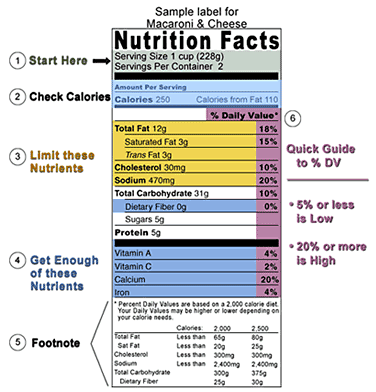 Image Credit: United States Food and Drug Administration (USFDA), 2004 / USFDA
Image Credit: United States Food and Drug Administration (USFDA), 2004 / USFDAA photo of a nutrition facts label is categorized into 6 separate parts. At the top of the nutrition facts label is the serving size which will give a measurement of food related to the rest of information on the label. Underneath the serving size is the caloric value of the food. Beneath the calories are a list of fats, sodium, carbohydrates and protein all of which should be limited in daily intake. Further down the label are nutrients such as vitamins that a person should aim to get enough of every day. The bottom of the label contains a footnote explaining how calculations regarding the label are made. Finally the last section is on the right side of the label and is labeled daily value. This section shows a percentage of how much of each nutrient is in the food and is calculated using assumptions made in the footnote.
When you read a "Nutrition Facts" label, the information is organized into a table. The "Percent Daily Value" is one of the important pieces of information found on the label (US FDA, 2004).
In this experiment, you will devise a way of testing foods for supplemental iron additives using a blender, water, and a magnet. Then you will use your design to test different breakfast cereals for how much iron they add. Then you will compare your results to the reported percent daily value of iron on the nutrition facts label. Will your results agree with the label? Which cereal will have the most iron in it?
Terms and Concepts
To do this type of experiment you should know what the following terms mean. Have an adult help you search the Internet, or take you to your local library to find out more!
- Food additives
- Vitamin and mineral supplements
- Percent daily value
- Iron
- Slurry
- What kinds of additives are contained in processed foods?
- How can supplemental iron be removed from a processed food for testing?
- How does the iron content of different breakfast cereals compare?
Bibliography
There are many different versions of this experiment, and here are links to a few of them:
- APS, 2007. PhysicsCentral: Physics at the Breakfast Table, American Physical Society (APS). Retrieved December 2, 2011.
- Bayer, 2007. "Experiment Guide: Nails for Breakfast?" Making Science Make Sense, Bayer Inc. Retrieved December 2, 2011.
This site at the U.S. Food and Drug Administration (US FDA) explains how to read a "Nutrition Facts" label and what the information on the label means:
- USFDA, 2004. How to Understand and Use the Nutrition Facts Label, United States Food and Drug Administration (US FDA), Center for Food Safety and Applied Nutrition. Retrieved December 2, 2011.
Materials and Equipment
- Four Cereals including:
- One cereal with an iron content of 25% DV or less
- One cereal with an iron content of 25% - 75% DV
- One cereal with an iron content of 75% DV or more
- Any other kind of cereal you like!
- Blender
- Plastic, clear one liter bottles with smooth sides (4)
- Distilled water (2 gallons)
- Heavy-duty magnet (of any type)
- Scissors
- Duct tape
- Large bowl
- Metric measuring cup with a spout
Experimental Procedure
- Choose four kinds of breakfast cereal to test with varying iron contents (see the Materials and Equipment for details). You will need 250 milliliters (mL) (a little more than one cup) of each cereal for the experiment.
- Ask an adult to help you cut off the bottom of all four plastic bottles. Take off the lids of the water bottles. When you turn the bottles upside down, they will work as funnels.
- Tape the magnet on the outside of the bottle about half way down using the duct tape, as shown in Figure 1 below. Label the bottles with the types of the cereals that you will test.
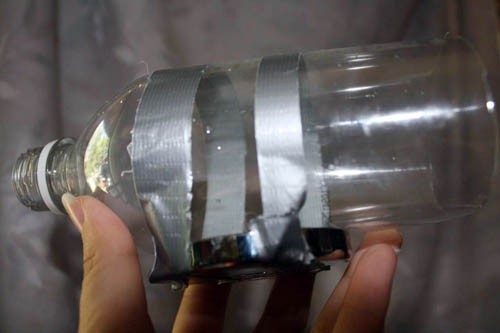 Image Credit: Science Buddies
Image Credit: Science Buddies
Figure 1. Take one of the cut-off plastic bottles and use the duct tape to securely tape the magnet to the side of the bottle, about halfway down. The magnet will work to catch the iron in the cereal slurry.
- Put 250 mL of one type of cereal in the blender and add 250 mL of distilled water.
- Blend the water and cereal on high until you have a smooth slurry and there are no visible lumps or chunks of cereal left.
- Carefully pour the slurry into the measuring cup.
- Rinse the blender with a small amount of water (20 mL) and pour this rinse into the measuring cup.
- Take the bottle that goes with the cereal you are using and hold it above the large bowl. Position it on its side with the cut-off part slightly higher than the top and rotate it so that the magnet is on the bottom side of the bottle, as shown in Figure 2 below.
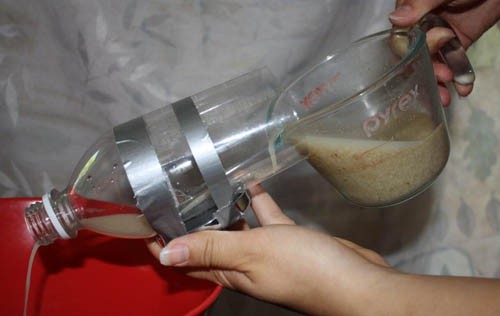 Image Credit: Science Buddies
Image Credit: Science Buddies
Figure 2. Position the bottle above the large bowl so that the bottle's top (where the lid was) is slightly lower than the cut-off part and the magnet is on the bottom side. Then slowly pour the slurry through the bottle, over the magnet, so that the liquid is collected in the large bowl.
- Slowly pour the slurry through the bottle, making sure the slurry goes over the magnet and the liquid is collected in the large bowl, as shown in Figure 2 above.
- If the slurry becomes solid and hard to pour, put the cereal back in the blender along with 100 mL of distilled water and blend. Pour the slurry back into the measuring cup and continue pouring it through the bottle. Depending on the cereal, you may have to do this four or more times.
- After all of the cereal slurry has been poured through the bottle, pour an additional 150 mL of water through. This rinse will get rid of the cereal that is in the bottle and clean the iron.
- Invert the bottle to get rid of water that is still in it. Remove the magnet from the bottle.
- Leave the bottle to air-dry for 1-2 hours. Choose a location that is not windy or breezy so the bottle will not roll. After this, the pellet of iron should be visible on the side of the bottle, as shown in Figure 3 below.
 Image Credit: Science Buddies
Image Credit: Science Buddies
Figure 3. After completing this experiment, you may see a pellet of iron on the side of the plastic bottle, which is labeled above in yellow.
- Repeat steps 3-13 with the other three cereals.
- Create a scale for rating the amount of iron you collected. A very simple scale, using only four states, could be: not present, small, medium, or large. Be sure to write the code for your scale on your poster so that others will know how you scored your results.
- Write your data in a data table:
| Name of Cereal | Percent Daily Value of Iron (%) | Did a Pellet Form? (Y/N) | Relative Iron Pellet Size |
|---|---|---|---|
- Make a scatter plot of your data. Make a scale of the percent daily value of Iron on the left side (y-axis) of the graph. Make a scale of the "Relative Iron Pellet Size" on the bottom (x-axis) of the graph. Draw a symbol for each type of cereal where the "Relative Iron Pellet Size" and the "Percent Daily Value of Iron" intersect.
- Analyze your data and make your conclusions. Which cereal(s) had the most iron? The least?
- If you like, transfer your iron powder to a square of plastic wrap. Carefully fold the plastic wrap over a few times to seal in the iron powder. Label each square with the type of cereal the iron powder came from using a permanent marker. Now you can attach your iron collection to your poster!
Ask an Expert
Global Connections
The United Nations Sustainable Development Goals (UNSDGs) are a blueprint to achieve a better and more sustainable future for all.
Variations
- If you have access to a scientific balance at your school, you can accurately weigh your results to get more quantitative data. For this to work, it will be important to also weigh your cereal in grams (g) before you put it in your blender and write this value in your data table. Each time you use the balance, you will need to place a piece of weight paper on the scale and tare (zero) the scale. After you are done with the experiment, carefully open your plastic wrap and pour the iron powder onto the paper. Record the mass in milligrams (mg) in a data table. Next you will need to divide the weight of the iron in milligrams by the weight of the cereal in grams so that your measurement of iron will be in MG of iron PER GRAM of cereal (mg/g). Now you can graph the Percent Daily Value of Iron (%) versus the Amount of Iron per Gram of Cereal (mg/g). Does your data make a line? What do you think it means?
- There are other foods that also contain iron supplements. Try testing other types of foods with a similar experiment. Here are some other ideas:
- Enriched breads
- Baby formula
- Infant cereals
- Energy bars
- Vitamin supplements
Careers
If you like this project, you might enjoy exploring these related careers:
Related Links
- Science Fair Project Guide
- Other Ideas Like This
- Biotechnology Project Ideas
- Cooking & Food Science Project Ideas
- My Favorites


